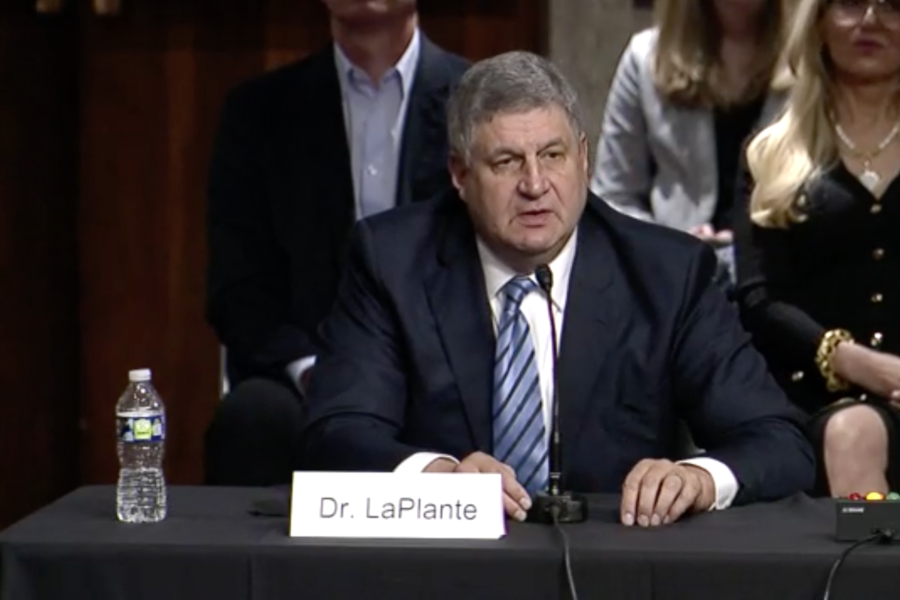The Pentagon and the defense industrial base need to up production lines for munitions, drones, and other key weapons systems—and quickly—the nominee to lead the Defense Department’s acquisition enterprise told a Senate panel March 22.
William LaPlante, nominated by President Joe Biden to serve as undersecretary of defense for acquisition and sustainment, also agreed with several members of the Senate Armed Services Committee during his confirmation hearing that more has to be done to increase competition and ensure future systems can be upgraded on the fly.
Most immediately, though, LaPlante advocated for more manufacturing across the board.
“I would say, to start with, we as a country have to have more hot production lines, period,” LaPlante told Sen. Tammy Duckworth (D-Ill.), who raised the issue of supply chain choke points during a potential conflict.
In recent months, concerns over the strength of the defense industrial base have grown. The National Defense Industrial Association gave the base’s health and readiness a failing grade in February, and a recent DOD report sounded the alarm on consolidation potentially raising costs and risks to the supply chain.
In March, Air Force Chief of Staff Gen. Charles Q. Brown Jr. and Space Force Chief of Space Operations Gen. John W. “Jay” Raymond both referred to the industrial base as “fragile” and questioned whether it would be able to surge production if needed.
The question of surging production came up during LaPlante’s hearing, as Sen. Jim Inhofe (R-Okla.) asked whether the Pentagon and Congress need to make immediate one-time investments to “expand production of key munitions” in the wake of Russia’s invasion into Ukraine.
“Yes, we do. I believe—and Senator, you said the words ‘hot production lines’—I believe we need multiple hot production lines, whether it be munitions, UASs, and the like,” said LaPlante. “They, by themselves, are a deterrent, and we need to put much more focus on that across the board.”
That focus on munitions and unmanned aircraft systems—both of which the U.S. has sent to Ukraine as part of military aid packages—came up again when Sen. Rick Scott (R-Fla.) asked LaPlante what he would change to bolster production and ensure more research and development projects don’t stall in what is commonly called the “Valley of Death.”
“One would be to up the production lines of the production lines we currently have—munitions, UASs—and just get them higher production,” LaPlante said. “But the second is working all the weapon systems across the Valley of Death, to make sure we’re injecting technology into the systems we have, because we have the program officers over here that have the weapon systems, and we have the technologists over here. We have to make that pipeline goal and make it a metric for success.”
LaPlante’s focus on increasing large-scale production is in line with Air Force Secretary Frank Kendall’s stated focus on delivering real operational capabilities over “one or two leave-behind unmaintainable token prototypes that came out of an experiment.” LaPlante and Kendall previously worked together when LaPlante was the Air Force’s acquisition boss and Kendall was the acquisition chief for the Pentagon—in his opening statement March 22, LaPlante thanked Kendall for his mentorship.
LaPlante’s background in the Air Force came up again when he was asked by Inhofe which programs the DOD should take more risks with in hopes of encouraging innovation.
“We learned the lesson from both [USS] Ford, and we’d like to think we learned a lesson from F-35 that you have to have mature technologies; you have to be thoughtful in the design; and you have to adhere to independent cost estimates right from the beginning,” LaPlante said. “It takes a little bit of time at the beginning, saves a lot of trouble later.
“But to get innovation, what you have to do is we have to build the modular systems like we did for the B-21. And so once you have the open system, then you can be upgrading the technology very fast. And the technology that matures will earn its way on and you have continuous upgrades. It can be done.”
The development of the B-21, which is moving closer and closer to its first flight, has been held up as an example of innovation by many, including Sen. Angus King (I-Maine), former Google CEO Eric Schmidt, and then-Air Force Global Strike Command head Gen. Timothy M. Ray.
The B-21 “was designed with an open standard right from the beginning, such that continuous technology can be upgraded for the next decades to come. That should be in all our systems,” LaPlante told King.
LaPlante also noted that increased consolidation in the defense industry threatened to drive up prices and decrease competition. To combat that, he said, DOD needs to once again focus on operational capabilities and overcoming the Valley of Death.
“Small businesses and industry have to see that there’s skin in the game, that they have a viable line of business if they’re successful and innovative, [and] they don’t just get a one-off contract for a prototype,” LaPlante said.
LaPlante’s nomination faced little resistance in the SASC hearing, putting him one step closer to confirmation for a position that hasn’t had a permanent appointee since January 2021. Biden’s first pick for the job, Defense Innovation Unit head Michael Brown, withdrew his nomination amid scrutiny that he allegedly circumvented hiring regulations at DIU.
